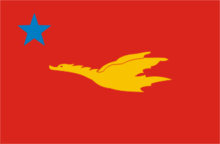Mon National Liberation Army
The Mon National Liberation Army ( MNLA for short ) is the armed arm of the New Mon State Party (NMSP), a political group that campaigns for the rights of the Mon people in Myanmar (Burma).
history
The NMSP and the MNLA were founded by Nai Shwe Kyin in July 1958 after the Mon People Front surrendered to Burmese forces. The area of operations of the MNLA included the southern Mon State , parts of the southern Kayin State and parts of the Tanintharyi Division . For almost 40 years they waged an armed struggle against the central government of Myanmar.
In February 1990, the MNLA lost its headquarters at Three Pagoda Pass on the border with the Thai province of Kanchanaburi in an offensive by the Burmese army against ethnic rebels. By losing the border crossing, the Mon lost their main source of income, customs revenue from trade with Thailand. 30,000 Mon fled to Thailand. In 1991 the Thai government tried to put pressure on the NMSP. She should lead ceasefire negotiations with the Burmese military regime, the State Council for Peace and Development (SPDC). The Thai government had signed a contract with the SPDC to build the Yadana pipeline through the Mon area.
Because of this, she put pressure on rebel armies to lay down their arms. After the construction of the gas pipeline began, 20,000 months were relocated along the route of the pipeline. In 1994, the Thai government forced the Mon refugees in Thailand to return to MNLA-held areas. But the Burmese army raided the newly built camps and burned them down. On June 25, 1995, the NMSP negotiated a ceasefire with the Burmese government. It turned out that the MNLA was unable to protect the Mon population. The armistice was only agreed orally, written documents do not appear to be available. The MNLA was allowed to keep its guns and got control of some areas in Mon state. But the MNLA had to withdraw from large areas. In 1995 the MNLA had a strength of 6,000 armed men.
The ceasefire has lasted for more than 10 years, but not without problems. In November 2001, a group led by Nai Pan Nyunt split from the MNLA and NMSP and formed the Honsawatoi Restoration Party with one armed arm, the Monland Restoration Army .
literature
- Ashley South: Mon Nationalism and Civil War in Burma. The Golden Sheldrake. Routledge, Abingdon / New York 2003.

